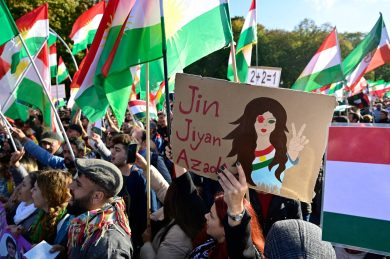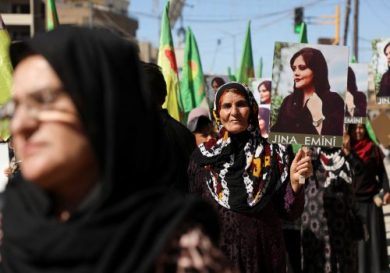In Iran, where state censorship and surveillance are tools of oppression, social media has become a battleground for resistance. Iranian women, long subjected to state-mandated gender restrictions, have transformed digital platforms into spaces of defiance, activism, and global awareness.
From the “Women, Life, Freedom” movement to online campaigns against compulsory hijab laws, social media has allowed Iranian women to bypass censorship, document human rights violations, and mobilize global solidarity against the Islamic Revolutionary Guard Corps (IRGC) and its repressive tactics.
This article explores:
• How Iranian women use social media as a tool for resistance.
• The IRGC’s efforts to suppress digital activism.
• The impact of online movements on Iran’s fight for democracy.
• How the global community can support Iranian digital activists.
1. The Rise of Digital Resistance
A. The Power of Social Media in Iran
In a country where state-controlled media distorts reality, social media offers an uncensored truth. Platforms like Instagram, Twitter, Telegram, and WhatsApp have become critical spaces for:
• Sharing real-time footage of protests and state violence.
• Exposing human rights violations committed by the IRGC.
• Organizing demonstrations and mobilizing global awareness.
Despite the Iranian regime’s internet restrictions, tech-savvy activists continue to outsmart censors, ensuring that the world sees the true face of oppression in Iran.
B. Women Leading the Digital Fight
Iranian women have led some of the most influential digital resistance movements, using hashtags, viral videos, and social networks to fight back.
Key Movements:
• #WomenLifeFreedom – Became a global rallying cry after Mahsa Amini’s death, uniting activists across borders.
• #MyStealthyFreedom – Launched by Masih Alinejad, encouraging women to post photos without hijabs in defiance of Iran’s strict dress codes.
• #WhiteWednesdays – A campaign urging women to wear white headscarves or remove them entirely as an act of protest.
• #StopExecutionsInIran – Raising awareness about political prisoners and the regime’s use of execution as a tool of fear.
These movements have shattered the state’s monopoly on information, exposing the brutality of the IRGC and amplifying Iranian women’s voices worldwide.
2. How the IRGC Tries to Silence Women Online
The IRGC recognizes the power of digital activism and has employed harsh measures to suppress it:
A. Digital Censorship and Internet Shutdowns
• The regime frequently blocks social media platforms like Twitter, Telegram, and Instagram.
• During major protests, the IRGC enforces nationwide internet shutdowns, cutting Iranians off from the world.
• VPNs and encrypted apps are targeted, forcing activists to constantly switch tools.
B. Cyber Surveillance and Arrests
• Online activists and journalists are tracked, arrested, and interrogated.
• Women who share hijab-free photos or protest footage face harsh sentences for “spreading corruption.”
• State-sponsored hacking campaigns aim to infiltrate dissident networks and expose activists.
C. Propaganda and Misinformation
The IRGC spreads false narratives, attempting to:
• Discredit activists as “foreign agents” or “Western spies.”
• Manipulate online discourse by flooding social media with pro-regime content.
• Use fake accounts to harass and threaten Iranian women online.
Despite these tactics, Iranian women continue to resist, proving that digital activism is stronger than state repression.
3. Real Stories of Women Using Social Media to Resist
A. Masih Alinejad: The Exiled Voice of Iranian Women
An Iranian journalist and activist, Alinejad’s #MyStealthyFreedom campaign became a global movement.
• The IRGC plotted to kidnap her due to her influence.
• She continues to expose Iran’s gender apartheid through social media.
• Millions of Iranian women follow her activism against compulsory hijab laws.
B. Niloofar Hamedi: The Journalist Who Revealed Mahsa Amini’s Death
• Niloofar Hamedi was the first journalist to report on Mahsa Amini’s hospitalization, sparking the 2022 protests.
• She was arrested for “spreading propaganda” and remains imprisoned.
• Her reporting proved the power of social media in exposing IRGC brutality.
C. Sepideh Gholian: Defiant Even Behind Bars
• A labor rights activist, she has been repeatedly imprisoned for reporting on worker exploitation.
• Even after release, she continues to expose IRGC abuses.
• Her story inspires thousands of Iranian women to keep resisting.
These women—and countless others—show that social media is a tool of resistance that the IRGC cannot fully control.
4. The Global Impact of Iran’s Digital Resistance
Iranian women’s digital activism has had international consequences:
• Governments worldwide have condemned Iran’s internet blackouts and repression.
• Tech companies have been pressured to support Iranian users with VPNs and secure communication tools.
• The Women, Life, Freedom movement has inspired global feminist protests.
The IRGC’s crackdown on digital activism has failed to stop global awareness, proving that online resistance transcends borders.
5. How the World Can Support Iranian Women’s Digital Resistance
A. Amplify Their Voices
• Share content from Iranian activists.
• Use hashtags like #WomenLifeFreedom #BanIRGC #FreeIranianWomen.
• Engage with independent Iranian journalists and human rights groups.
B. Demand Tech Companies Protect Activists
• Push for stronger encryption tools to protect Iranian users.
• Support circumvention technologies like VPNs and satellite internet.
• Hold social media platforms accountable for removing activist content due to state pressure.
C. Pressure Governments to Act
• Advocate for stronger sanctions on the IRGC’s cyber units.
• Support global resolutions condemning Iran’s digital repression.
• Fund independent Persian-language media to counter IRGC propaganda.
Conclusion: The Digital Battle for Freedom
Social media has become Iranian women’s most powerful weapon against the IRGC’s tyranny. Through online activism, viral campaigns, and global connections, they have exposed state brutality, mobilized international support, and inspired a new generation of resistance.
Despite censorship, arrests, and cyberattacks, Iranian women continue to lead the fight for freedom online. Their digital defiance proves that oppression cannot silence a movement whose voice has gone global.
“The IRGC may control the streets, but Iranian women own the internet.”
Join Our Newsletter!
Stay informed with the latest updates, news, and ways to take action in the fight for justice and global security. Sign up now to get updates delivered straight to your inbox!





